Chapter II
The Pre-Pagan Period:
The Urban Age of the Mon and the Pyu
A. Pre-Pagan Period: Introduction - General
History
The first millennium AD in Burmese history, The Urban Age, is
characterized by the first appearance of cities and the formation of
nation states. Of great importance in this process was the arrival from
India of
a wide variety of ideas and beliefs, both religious and secular. The
occurrence of urbanism and Indianization at this time is shared by other
polities in mainland Southeast Asia and should be considered a regional
phenomenon even though the earliest known city, Beikthano, is found in
Burma. Indeed, coins minted in Burma have been found in urban sites as
far away as northern Thailand and southern
Vietnam.
It was also during this period that sophisticated irrigation systems using
weirs were established in the central dry zone and henceforward the dry
zone remains paramount in Burmese political life and history.
As evidenced by artifacts and inscriptions, an array of religions were
practiced during the Pyu period such as Hinduism and in particular
Vaishnavism, Theravada Buddhism, Mahayanna Buddhism, Tantrayanna Buddhism
and a vast range of uncodified animist beliefs and rituals. By the end of
this period, the major Animist spirits (Nats=Burmese) had been
subordinated to Theravada Buddhism which become the religion of choice
among the lowland rice farmers and Theravda Buddhism has remained the
predominant religion in Burma until the present day.
From approximately 200 BC, a number of walled cities were built in central
Burma whose plans consisted of rounded squares or rectangles. It is
believed that circular shapes (at times oval, as in ancient Thai sites)
was an indigenous Southeast Asian creation whereas the square or mandala
plan was imported India. Upon examining aerial photographs of these cites,
it is obvious that the dichotomy between circular and square is not
clear-cut. The corners of the city walls have been rounded as well as the
entrances to the gateways and in addition, the city walls are not straight
but bulge elliptically. Some features of the Pyu cities are certainly of
Indian origin such as the use of twelve gates. Therefore the plans of
these early cities show a mixture of traits, some indigenous, some
borrowed.
Although the Burmese began to live in cities before the arrival of Indian
ideas, these foreign ideas were essential to create important capitol
cities of international and cosmological significance. The adoption of
Indian concepts of city planning incorporated a belief in the efficacy of
the world axis that connects the centermost point in a properly
constructed Mandala city with the city of the Gods above (Tavatimsa
heaven) in order to assure prosperity throughout the kingdom below.
A
remarkable characteristic of the Mon and Pyu cultures is that they minted
and used silver coinage. The earliest type of these uninscribed coins
depicts a conch on one side and a Srivatsa (a door-like symbol associated
with good fortune) on the other. These coins date from the 5th century,
originated in the Pegu area, and became the model for almost all coinage in
mainland Southeast Asia during the first millennium AD. The later Pyu coins are
derived from this earlier Mon type and appear in several varieties till
the end of the 8th century AD. Many of these coins have had a
small hole punched along their perimeter so that the coins may have been
used as much for amulets as for trade. After the Pyu Period that ended in
the late 9th century, coins were not used again in the Burmese
kingdoms until the 18th century!
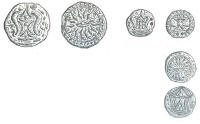
Pyu
coins |
B.
The Mon People of the Coastal Regions
1. General History and Introduction
The first Indianized peoples in
Burma were the Mons. An honor shared
with their northern neighbors, the Pyus. The Mons, a people of Malayo-Indonesian
stock, are related to the early inhabitants of Thailand and Cambodia who
also spoke Mon-Khmer languages. The Mons who are considered to be the
indigenous inhabitants of lower Burma, established their most significant
capital at Thaton, strategically located for trade near the Gulf of
Martaban and the Andaman Sea.
Little is known of the early history of the Mon people including how long
their various kingdoms flourished and the extent of their domains. For
example, it is not definitely known if it was the Mon or the Pyu who
controlled the lower delta region. Descriptions in Chinese and Indian
texts specify their settlement area as being around the present day cities
of
Moulmein and Pegu in the monsoonal plains of Southeast Burma. This area
was first known as Suvannabhumi ("land of gold") and later as Ramannadesa
("Land of Ramanna"); Ramanna being the word for Mon people. The area
known as Suvannanbhumi was often connected with the historical Buddha in
the later Mon and Burmese chronicles that credit the Mons
with first establishing the Buddhist religion in Burma.
Although little is known about actual religious practice, trade
connections through the Mon port city of Thaton can be traced to the
Indian kingdom of the Buddhist King Ashoka from as early as the 3rd
century BC. Legend maintains that 2,500 years ago the Mon people began the
original structure of the Shwedagon Pagoda that today has become the most
revered Buddhist stupa in Burma, a true national monument. This
theory, though tenable, lacks objective corroboration because the many
changes that have been made to the pagoda over the years have repeatedly
encased its original structure and there is no contemporary record of its
foundation or a description of its form.
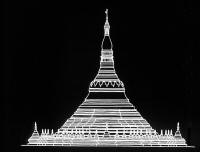
Plan of The Shwedagon Stupa, Rangoon |
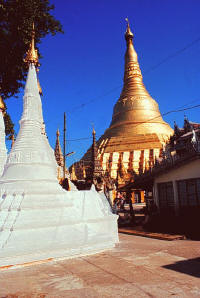
Upper Terrace, Shwedagon, Stupa, Rangoon |
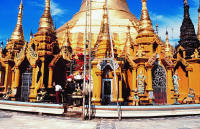
Small ShrinesUpper Terrace, Shwedagon, Stupa, Rangoon |
Once a very powerful political and cultural group, today’s Mon population
of around 1.3 million has been mostly absorbed into the mainstream of
Burmese culture. These Burmese Mons make up only a small part of the
Mon-Khmer speakers of
Southeast Asia with many of their
relatives living further to the east in Thailand and Kampuchea. Although
their culture has merged with that of the Burmese, the Mons
have continued to use their own language and since 1962 have had their own
state. As devout Buddhists, they follow their own ceremonial calendar of
Theravadin festivals. Their main source of livelihood comes from the
cultivation of rice, but they also grow other crops such as yams, sugar
cane, and pineapple.
2. Pre-Pagan Period: Thaton
a. Introduction
The early Mon kingdoms that were in power during the prehistoric period,
were situated between the Sittang and
Salween rivers and were referred to
as Ramannadesa. Thaton, the seat of this kingdom, is believed to have been
Suvannabhumi (“Golden Land”), a term that was also used to refer to the
whole region of continental
Southeast Asia
bordering the Bay of Bengal. Thaton is thought to have been founded by
King Siharaja during the lifetime of the Buddha, which would place it in
the fifth century BC. Thaton was once a flourishing port community that
communicated with and transported goods from as far away as Southern
India. Later Burmese chronicles credit the Mon people of Thaton with
bringing the Buddhist religion to Burma. In these chronicles it is also
stated that Buddhist manuscripts from Sri Lanka were translated into Mon
characters around 400 AD. Although scholars have questioned this fact, it
is known from local inscriptions that Theravada Buddhism definitely
existed in Lower Burma by the fifth century AD. Although the exact
founding date of Thaton and the extent of its kingdom has yet to be
discovered, it is known that Thaton fell under Burmese control during the
11th century when the first great King of Pagan, Anawrahta, sacked the
city and returned to Pagan with Thaton’s King Manuha as his captive.
Thaton remained under Burmese domination until the fall of Pagan in 13th
century. Thenceforth, the Mons re-established their independence, although
the capital was later moved to other locations including Marataban and
Pegu.
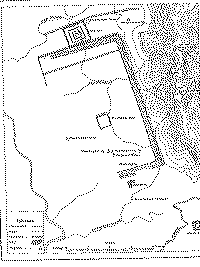
City Plan of Thaton
Thaton’s quadrangular city plan resembles that of the later Burmese cities
of Amarapura and
Mandalay. Four walls surrounded the
old city creating a rectangular shape that enclosed the walled palace
compound that was located at its center. From north to south the palace
site measured 1, 080 feet and 1, 150 feet from east to west. Two chief
stupas were situated between the palace site and the south wall. Today,
the old city of
Thaton is no longer visible as growth of the modern town
has obscured the earlier settlement.
b. Pre-Pagan Period: Thaton - Architecture
Of the two stupas situated between the palace site and south
wall, the Shwezayan is the largest. Across the road from the Shwezayan
stupa is the Kalyani Sima, a hall built especially for the ordination of
monks. On the sandstone boundary pillars that surround the Kalyani Sima,
the stories known as the Ten Great Jatakas may be seen. These carvings
illustrate the last 10 lives of the Buddha before he was reborn as Gautama,
the historical Buddha who gained enlightenment. An inscription on one of
the pillars dates them to the 11th –13th centuries.
i.
Swezayan Stupa
The original form of the Swezayan, stupa, said to have been
built in the 5th century BC, is difficult to ascertain since it has been
repeatedly rebuilt and expanded. As it stands today, the stupa has a
circular base and its overall structure resembles that of a bell. Found
within the compound of the Swezayan stupa are several inscribed stones,
five in the Mon language of the 11th century. These stones are now
preserved within the stupa compound.
Also found within the building are several stone sculptures, loosely dated
to the 10th-11th centuries. One of these is a relief carving on sandstone
of a standing Buddha. His right hand held at his side points downward with
the palm facing outward in the wish-granting gesture known as varada mudra.
His left hand is held upwards against his chest with the thumb and index
finger pressed together in the argumentative or teaching attitude known as
vitarka mudra. Above the Buddha’s shoulders are the figures of hamsa
birds facing each other.
c. Sculpture: Thaton
The relatively few pieces of sculpture that can be dated to this early
period vary greatly in style and in subject matter. The subjects portrayed
are of Hindu, Buddhist and Animist gods. Two Hindu sculptures dating to
the 9th – 10th centuries are carved from slabs of
reddish sandstone and depict in high relief the figure of Vishnu reclining
on the serpent Ananta. From his body issues a tripartite lotus stem on
which are seated Brahma, Vishnu and Siva. This configuration is peculiar
to Pyu art. In India, the usual presentation of this event shows a
single god, Brahma, appearing within a lotus flower that grows from
Vishnu’s navel.
Another Hindu sculpture is that of the four-armed Siva seated with his
vehicle, Nandi, the bull below his right leg and the buffalo-demon under
his left knee. From slightly later are two small images of Ganesa and a
small sculpture of a seated Brahma. All of these sculptures were removed
to the
Phayre Museum at
Rangoon and then loaned to the Rangoon University Library
where they were located when the Japanese destroyed the building during
World War II. Consequently, they are known today only from fragments and
photographs.
C.
The Pyu People
1. General History
The Pyu people settled inland along the middle reaches of the
Irrawaddy River
but at a distance from the river’s course. This is in sharp contrast to
the later Burmese cities such as Pagan, Ava, Amarapura, and Mandalay that
were situated directly on the riverbank. The Pyus developed a system of
irrigation using elevated weirs as well a sophisticated system of urban
planning. The Pyus adopted Buddhism as it spread into Southeast Asia while
continuing to practice animism, the worship of indigenous spirits.
Excavations at the great Pyu capitol, Srikshetra, uncovered artifacts
associated with Vishnu as well as the remains of Buddhist stupas and
monasteries that clearly indicate that Hinduism as well as Buddhism were
practiced there. Indeed, the name of the earliest Pyu city, Beikthano,
means the “City of Vishnu”, the second of the great gods in the Hindu
Triad. Due to the scarcity of written material, little is known about the
Pyu peoples themselves. Although the Pyu had a written language, few
examples still exist. The Pyu language and culture seems to have
disappeared as they were conquered and absorbed by the Burmese. The Pyu
and Burmese languages are similar, both belong to the Tibeto- Burman
family of languages. Most of what we do know of the Pyu is extrapolated
from archeological excavations, surface finds and scant references in
Chinese Dynastic Histories. Additional but very limited information is
found in the few inscriptions on burial urns that typically state the
names and reignal dates of early rulers and in the formulaic inscriptions
on Buddhist votive tablets. None of these sources yields detailed
information about the Pyu people or their culture. In fact, it wasn’t
until 1911 that the Pyu language could be read. This was the result of the
translation of the Myazedi Inscription, the Burmese “rosetta” stone. This
quadrilingual inscription, written in the Pyu, Mon, Burmese, and Pali
languages, was
erected before the (Buddhist) Myinkaba Kubyauk-gyi
Temple at Pagan in 1113 AD. That this Pagan inscription was written in
Pyu in the 12th century suggests that although Pyu culture had
declined in the 9th century due to invasions from the North by the Chinese
and had been subsequently absorbed by the Burmese, the Pyu had
continued as an important presence for over three centuries after the
Chinese invasions.
However, little is heard or known of the Pyu after the 12th century.
2. The Pyu City of Beikthano
a. Introduction:
Beikthano – 1st to 5th centuries AD.
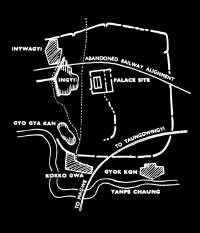
Plan of Beikthano |
One of the earliest Pyu sites is Beikthano, the City of
Vishnu, which is
situated near the east bank of the Irrawaddy River
between Srikshetra and Pagan. Little of the ancient city exists today
because its once tall brick walls were quarried to construct roads and
railway tracks. Therefore, most of what is known of Beikthano is the
result of archaeological excavations carried out in the twentieth
century. Among the excavated structures were found the ruins of Buddhist
monasteries, although no Buddhist statuary was found; two pillared halls;
four stupa–like buildings; and a city wall made of fired brick enclosing
an area of over 2.8 kilometers. The excavations produced artifacts that
can be categorized as having essentially Pyu characteristics: silver coins
bearing symbols of prosperity and good-luck, burial urns of both plain and
elaborate designs, beads of clay and semi-precious stones, decorated
domestic pottery, iron nails, and metal bosses. This assemblage of
artifacts is shared with the later Pyu cities of Halin and Srikshetra.
Through the analysis of the structures, pottery types, particular marks on
potsherds, the inscriptions on a clay seal and on burial urns, the period
in which Beikthano existed can be established as the 1st –5th
centuries AD.
b. Beikthano: City plan
The city plan of Beikthano resembles a bulging rhombus, each side of the
city wall measuring about two miles, although little remains today due to
natural decay and human depredation. Excavation revealed twelve gateways
where the walls curved inward to create entrance passages, each
terminating in massive gates. In each of these passages the burnt
remains of a wooden gate and rusted iron sockets were found. A rectangular
brick enclosure, referred to as the Palace site, lies approximately at the
center of the walled city. In the center of the eastern wall of this
palace enclosure there is an inner gateway that unlike the curved
entrances along the city walls has a square entrance. On either side of
all the excavated gates was found an indented space for guards or
sentries. Near the entrance to the palace site, two huge pairs of
feet carved in sandstone were found. Although the upper portions are
missing, these were no doubt once massive figures of door guardians.
c. Beikthano:
Architecture
Of the over one hundred debris mounds that are present at Beikthano,
twenty-five of them were excavated between 1959 and 1963 (new excavations,
it is reported, are presently underway). While artifacts, and coins have
come to light, little is known concerning the details of the physical
structures at the site since they now exist only as fragmentary
foundations. The foundations of a number buildings made of large,
kiln-fired bricks were unearthed, among them are two halls with wooden
pillars, possibly audience halls; a large rectangular monastery building
containing multiple cells; and the foundations of several circular, stupa-like
structures, a few of them situated on square bases. These stupa-like
foundations were in several cases closely associated with numerous burial
urns containing the ashes and bones of cremated human bodies.
i.
The Monastery Building
To the north of the palace site lies the most important structure at
Beikthano: a large multi-room building that was almost certainly a
monastery. The structure of the building was made of well-fired bricks
with wooden doors and window frames. This building, evidently used as a
residential dwelling for monks, was destroyed by fire as indicated by the
charred remains of its wooden fittings. The remains of the brick walls
now rise to about 8 feet. The building consisted of a main rectangular
structure measuring about 100x35 feet with a smaller rectangular
projection on the east side. The floor plan consists of ten rooms: one
entrance hall on the east occupying the projection, one long corridor hall
occupying the eastern half of the main rectangle and eight small square
rooms to the west of the long hall. The wall opposite the only exit on the
east leads to a long corridor, which is connected by a large door to all
of the small rooms. The several, small and identical rooms within this
building resemble those of Buddhist monasteries at Nagarjunakonda in
Andrha
State of South India.
Since this building is found in close proximity to one of the stupa-like
structures, it was almost certainly built as a residence for monks.
This structure can be dated by an impression in clay discovered within
that was stamped
with a circular seal containing four letters in Brahmi script that are
datable to the second century AD.
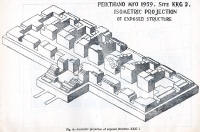
Drawing of
Beikthano monestary foundation |
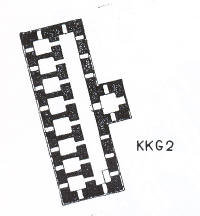
Floorplan of
Beikthano monestary |
Among other structures exposed at Beikthano is a cylindrical building with
four rectangular projections outside two concentric retaining walls that
resembles the typical Andhra type of stupa found at Amaravati and
Nagarjunakonda in Southern India. The Andhra stupa type typically has
rectangular ayaka platforms that project at ground level from the cardinal
points. Here the projections are very prominent but do not support any
inscription pillars nor is the drum of the stupa decorated with sculptured
stone slabs as in the Indian prototype.
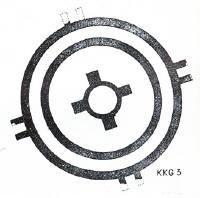
Floor plan of stupa-like building |
ii.
Stupa-like foundations
Another type of religious or ritual structure that was uncovered in three
excavations consists of a square base on which originally stood a
cylindrical structure, perhaps surmounted by a low hemispherical dome,
which would be like the stupas at Nagarjunakonda. There were no
projections from the drum itself but a rectangular wall projected from one
side only and is a feature peculiar to Beikthano. Burial urns were found
associated with these structures, though not actually enshrined within
them. The urns typically were found in groups buried along the outer
perimeter of the structures in close proximity to the square foundation
base.
An extended human skeleton and two groups of human bones were recovered
outside the south and north walls of one of these structures. It is
evident from the stratigraphy that the urns and bones were buried at the
same time in a single layer. The absence of religious objects at this site
and the definite association of the structure with burial urns as well as
human skeletons strongly suggest that the building was used for funereal
purposes.
Also unearthed were the rectangular foundations of two halls built with
brick floors having openings for wooden pillars. These are located near
buildings thought to be monastic establishments, an arrangement that also
has South Indian precedents. Importantly, the placement of burial urns
around the foundation of these structures is a trait unique to the Pyu
culture of Burma and is not found in similar structures in South India.
d.
Beikthano: Sculpture
A
distinct curiosity of this site is the lack of any evidence for Buddhist
images, although they have been found at other Pyu city sites such as
Halin and particularly Srikshetra. One proposal to explain this curiosity
has been that it is an indication that a type of aniconic Buddhism that
does not employ images was practiced here and that the practice was
similar to that of the Aparaseliya and Mahisasaka sects of South India
that do not use images. On the other hand, all evidence of images may have
vanished if they were purposely and completely destroyed and/or
transported elsewhere.
e. Beikthano: Other arts
i.
Beikthano: Burial Urns
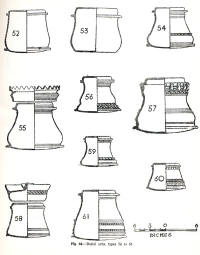
Burial Urns recovered at Beikthano |
A
wide variety of ceramic burial urns were discovered at Beikthano. Almost
all consist of a container base with a cover, though they vary
considerably in shape from spherical to water pot with neck, to
cylindrical with straight sides, to globularly cylindrical. Surface
ornamentation also varies greatly from resolutely plain to elaborate
sgrafitto and applique patterns. Most were found inside or just outside
the various structures with calcinated bones and ashes inside.
The burial urns found at Beikthano in some considerable abundance reveal
definite cultural links between Beikthano and the later Pyu sites of Halin
and Srikshetra. A great number of urns have been unearthed at Srikshetra
that show a similar pattern in their contents and their manner of burial,
however they are far less ornate in their decoration than many of the urns
at Beikthano. Although few urns have been found at Halin, their tall,
perpendicular sides are also quite similar to some of the urns found at
Beikthano.
Since the burial urns - and rarely, complete human skeletons- were found
buried in groups along the outer base of the stupa-like buildings, the urns must then have been used for secondary burials. This practice
necessitates having a place to store the cremated remains of several
individuals until a sufficient number of them are accumulated for a group
interment. Therefore, before the final burial could take place these
funeral urns appear to have been stored in religious buildings as a part
of sepulchral rites observed by the inhabitants of the Beikthano. Also,
large quantities of pottery of various types and calcified bones and
skulls were found within one of the structures unearthed at the site which
may be further evidence that it was used as a storage facility or
sepulchre for the cremated bodies awaiting burial.
ii.
Beikthano: Coins
Limited numbers of Pyu
coins -
typically marked with symbols but without
inscribed words - were found at
Bseikthano. The coins that have come to
light include types found at the later Pyu sites of Halin and Srikshetra
and thus establish an important cultural link between these Pyu sites.
3.
The
Pyu
City of Halin 2nd –6th AD
a. Halin: Introduction, General History
Halin, a Pyu city in northern Burma, is located north of Mandalay about 12
miles southeast of Shwebo and seems to have flourished from the 2nd to the
6th century AD. Preliminary excavations were carried out in 1904-5, in
1929-30 and again from 1963 to 1967. Although these excavations yielded
many small finds including burial urns, beads, shards, coins, engraved
gems, and metal implements as well as a few inscribed lines written in Pyu,
little architectural evidence other than the bases of square or
rectangular brick buildings were found. Even so, it is evident that the
remains at Halin are characteristically Pyu. That is with the exception
that no round stupas, large stone or metal images, nor clay votive tablets
were found, such as appear in some abundance at Srikshetra. A practice
prevalent at Halin that differs from Beikthano was the burial of
non-cremated human remains along with the funerary urns. The attack on
Halin in 832 AD by the Nan-chao of Yunnan, China, appears to have been a
devastating blow since according to the Chinese records the entire
population was carried off into slavery and after this date mention of the
Pyu is very rare.
b. Halin: City Plan
Of rounded rectangular shape, the brick-walled and moated city
is roughly two miles long and one mile wide. At present, the walls of the
city have crumbed almost to ground level. Most of the structures
themselves were below ground level and had to be completely uncovered
through excavation. Traces of the moat are seen on all sides except the
south. Three of the original twelve gateways were uncovered. The brick
city walls curve inwards at the onset of each entrance gateway and thus
create a protected passageway into the interior of the city. A rectangular
shaped outer wall with rounded corners was also delineated that is similar
to the city plan of Beikthano.
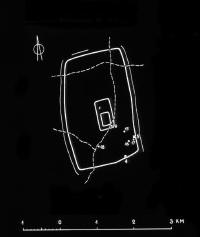
City Plan of Halin |
c. Halin:Architecture
The structures within the walls consist of square or rectangular buildings
that in several instances have a quadrangular projection from one side.
Earthen funerary urns were found buried both within and outside these
structures. Since these building reveal no evidence of a religious
purpose, they are thought to have been used solely to house funerary urns.
At a site situated near the “palace” a large rectangular hall made of
brick, possibly serving as an assembly hall was exposed. The charred
remains of 84 wooden pillars in four ranks are evidence of how the roof or
superstructure was originally held in place. Charred remains were
also found of the wooden gates that once stood at the entryways to the
city. An analysis of charcoal specimens from this structure thought to be an
assembly hall has produced a date of 6th century AD. Charcoal from two of
the wooden gates indicate a date to the 2nd or 3rd
century AD.
d. Halin: Other Arts
Although no Buddha images or clay votive tablets were discovered, Halin
has produced a rich trove of small artifacts. Objects such as decorated
sherds and beads of semiprecious stones, a few gold rings, two gold
pendants, two gold beads, one round and one barrel-shaped, and several
tiny disc beads of gold were found at different ritual structures. Irons
nails, knife blades, arrowheads and sockets for doors were recovered in
abundance. Of particular interest is a weapon called a caltrop made of
four, sharp, connected spikes that was used to impede the progress of
cavalry and foot soldiers. Among the domestic objects recovered were
three hand-mirrors made of bronze. Other finds, often by villagers,
consist of gold, silver, and bronze objects or ornaments but these have
frequently been melted down for the value of their metal or sold. Of
particular interest are a number of Pyu coins similar to those found at
Srikshetra. The only difference between them is that the symbol of the
rising sun seen on the Halin coins is replaced by the throne (bhadrapitha)
emblem as seen on the coins from Skrikshetra. An unusual coin type found
at Halin and rarely seen at Skrikshetra has a conch within the door-like
Srivatsa symbol. Also found were several stone slabs that unfortunately
bear only partially legible inscriptions. Of those that can be
translated, at least in part, the earliest is thought to be an epitaph
marking the site of the tomb of one Honorable Ru-ba while another gives
the name of a queen, Sri Jatrajiku.
4.
The
Pyu City State
of Srikshetra (Thirikhittaya)
a. Srikshetra: Introduction
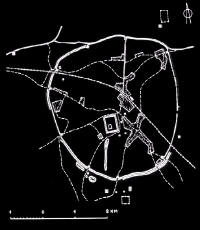
Map of Srikshetra |
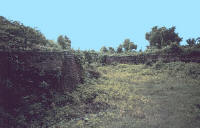
Curved walls create entry passage |
The largest and most important of all the Pyu capital cites, Srikshetra,
is located approximately five miles southeast of the modern city of Prome,
180 miles northwest of Rangoon, and a few miles inland from the left bank
of the Irrawaddy. The site of Srikshetra is known by several names:
Thayekhittaya, Hmawza, and Pyi in Burmese and as Old Prome in many English
publications. This ancient capital is thought to have reached its height
from the 5th through early 9th centuries, although Pyu culture had been
developing for centuries elsewhere in
Burma.
The culture of the people who once inhabited this great city can be
ascertained through the study of architectural, sculptural, epigraphic,
and artistic remains, which are relatively abundant when compared to other
Pyu sites. Unfortunately, due to the merging of Pyu and Burmese culture,
the Pyu language ceased to be used as early as the 13th
century. Consequently, it has not been possible to decipher a great number
of the inscriptions written in Pyu. The monuments, primarily religious,
reveal a close affiliation and communication with India, but as we have
seen in other Pyu sites, very few artifacts are identical copies of an
Indian form or concept - slight to major changes set these artifacts apart
from their Indian prototypes.
It is unknown precisely when and how Srikshetra, a very prosperous city,
declined. It is thought that as the Pyus were gradually absorbed by the
Burmans as Pagan grew in importance so that by the late 11th
century Pagan had become the undisputed capitol of a unified Burma
including the formerly Pyu territories.
b. Inscriptions
The earliest known examples of writing in Burma were found at Srikshetra
and employ an alphabet that is derived from those used in South
India. Two inscribed gold plates and a manuscript inscribed on
twenty gold leaves were found in the Bawbawgyi stupa that have been dated to the
second half of the 5th century. A stone slab bearing a Pali inscription
recites in verse excerpts from Buddhist texts (the Mangala Sutta, the
Ratna Sutta, and the Mora Sutta) and can be dated epigraphically to the 6th or 7th century. Numerous
inscribed votive tablets of clay depicting figures of the Budddha have
been uncovered. Interestingly, almost all the inscribed materials relate
to Theravada Buddhism, although there are images extant from other
Buddhist sects as well as other religions.
c. Srikshetra: City
Plan
Srikshetra’s city plan, unlike that of Beikthano and Halin, is more
circular or oval in shape. The city wall of well-fired bricks is
surrounded by a moat. The circumference of the wall is eight and one half
miles and in many sections, where the wall remains intact, rises as high
as fifteen feet. At each of the entrances or gateways into the city, the
wall curves inward, as at Beikthano and Halin, to form long corridors on
either side of the entrance passages. Also, the palace site is located in
the center of the city enclosure, as found elsewhere; is rectangular in
shape and measures 1,700 feet to 1,125 feet. The northern half of the city
is a low plain dominated by rice fields but rises gradually to the south.
Chinese records state that commoners lived and farmed their fields within
the great expanse within the city walls. This report also states that the
prosperity of the city is evidenced by more than a hundred Buddhist
monasteries, decorated with gold and silver, and painted many colors that
are hung with embroidered cloth.
A
19th century Burmese Chronicle, “The Glass Palace Chronicle”
was written at the order of the Burmese king and attempts to fit
Srikshetra into the Hindu-Buddhist ideal of the perfect royal
Capitol City.
This model is based on Sudarsana, the heavenly city of Indra (shaka:
Burmese) which is located on the peak of Mount Meru at the center of the
universe. The
palace of Indra is at the center of the city with the
palaces of the lesser 32 gods arranged around it. In both Hindu and
Buddhist thought, a city so arranged becomes a representation of the
“Heaven of the Thirty-Three Gods (Pali:Tavatimsa). The chronicle claims
that Srikshetra had all the things needed for such a city: 32 main gates
and 32 small gates, moats, ditches, four-cornered towers with graduated
roofs over the gates, turrets along the walls and so forth. In later
Burmese capitals, the gates of the city represented, and were often named
after, the chief vassals or provincial governors of the realm, with the
king at the center corresponding to the celestial god Indra. The
adoption of these beliefs and their use in city planning are a good
example of how attractive Hindu-Buddhist concepts were at providing
Southeast Asians with a respected place in the cosmos and also a place in
the international Asian world.
d. Srikshetra: Architecture
Although a number of structures still exist at Srikshetra such as temples,
and stupas, there is a growing consensus among scholars that only the
stupas date to the Pyu period. The temples were most likely constructed
during the Pagan period; many for the re-installation of older Pyu images.
At Srikshetra, the ancient ruins are concentrated in the elevated southern
half of the city and also outside the fortress-like walls, while burial
mounds containing urns were found scattered throughout the area. The three
most salient monuments today are all stupas and are found outside of the
city wall: the Bawbawgyi to the south, the Pyagyi to the northwest, and
the Pyama to the north. The Bawbawgyi, the tallest of the stupas is 153
feet high and consists of a massive cylindrical column that rests on a
base of five concentric terraces. The upper portions of the main cylinder
have fallen away over time and the truncated form has been fitted with a
tower that resembles the Burmese crown or hti (hti: umbrella). It is
therefore unknown what originally crowned this monument, as well as the
other stupas at the site. However, this cylindrical stupa form that tapers
towards the top is peculiar to Burma and to Pyu culture and is believed to
represent a closed lotus bud. This form is more completely retained by the
two other important stupas at the site, the Pyama and Pyagyi. The stupa in
the form of a lotus bud can be seen in its entirety on many of the
numerous votive tablets found at the site.
|
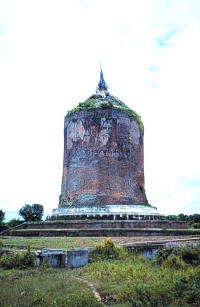
Bawbawgyi |
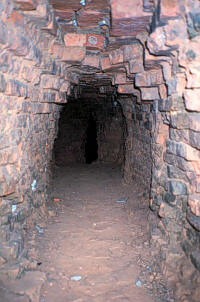
Passage inside Bawbawgyi |
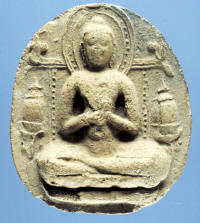
Votive tablet with
"lotus bud" stupas |
|
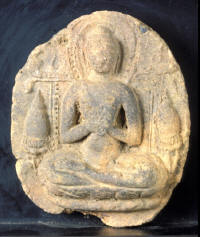
Votive tablet with
"lotus bud" stupas
|
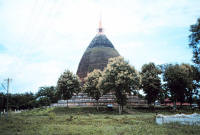
Pyagyi Stupa, general view
|

Pyagyi Stupa, tapering side
|
|
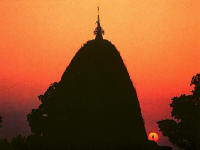
Pyama Stupa, general view |
|
|
The Bawbawgyi is not an entirely solid structure as it may appear at first
sight. Indeed, the cylindrical body is hollow up to about two-thirds of
its height and in this regard, differs from most stupas in Burma that are
typically solid and cannot be entered. There is an opening at the base and
another aperture high up in the opposite wall. Inside the stupa was found
a small ceramic vase containing excerpts from Buddhist manuscripts that
were written in Pali (=sacred language of Buddhism) on twenty sheets of
gold and silver. The script used in writing these passages has been dated
to the mid 5th to mid 6th century AD, which dates
the structure to well within the Pyu period. Also, clay votive plaques
inscribed with the name of the first great king of Pagan, King Anawratha,
were found inside the stupa in an especially created chamber. This too is
a clear indication that the structure predates the Pagan Period and is
therefore no doubt Pyu. King Anawratha’s continued reverence for the
Bawbawgyi is bitter-sweet, however, in that when the votive tablets were
placed inside, the relics contained in the stupa were evidently looted to
be taken away to Pagan to be re-enshrined there.
The stupas at Srikshetra lack the decorative architectural moldings and
motifs that are found on modern stupas which some scholars see as an
indication of their antiquity. However, others believe the decorative
elements were originally created in plaster and they fell away long ago.
Notable in architectural features although less in height than the above
mentioned stupas are three temples, the Bebe, the Lemyethna, and the East
Zegu. The Bebe and the Lemyethna are situated outside of the surrounding
walls while the East Zegu is located inside the perimeter of the city. The
Bebe temple, made of brick, has a small square sanctuary with a porch
facing east. On top of the hollow base are three receding terraces on
which stands a plain cylindrical pinnacle with a rounded top. The
sidewalls have attached columns with false arched doorways on the exterior
and arched niches inside. A sculptured stone slab bearing a seated Buddha
flanked by a disciple on either side rests against the west wall. The
Lemyethna is a small square temple with four entrances. The core is solid
and is surrounded by a narrow corridor and four porches. Originally, each
side had a stone slab bearing a seated Buddha image. It has a terraced
roof but the pinnacle no longer exists.
Both the Bebe and the Lemyethna were made using the same building
techniques and ornamental forms that were used later in Pagan buildings.
The apparent re-installation of several Pyu images within these temples
indicates that they are obviously later constructions, thus later Pagan
Period creations.
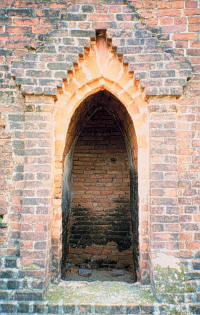
Pointed arch and form of door-surround like those found on temples at
Pagan |
Therefore, some scholars have considered the small temples at Srikshetra
to be the prototypes for the much larger temples at Pagan. Most scholars
now accept that these temples are provincial constructions dating to the
Pagan Period and are not Pyu at all.
e. Srikshetra: Sculpture
Srikshetra, in comparison to other Pyu sites, is unusual because of the
greater number as well as complexity of the images and artifacts that have
come to light. The diversity is found not only in subject matter but in
iconography as well. Also, objects were created by a variety of techniques
and media: for example, carved stone, cast bronze, gilded repousse silver,
beaten and repousse gold, inscribed copper, engraved gems, molded and
inscribed clay. Consequently, the artistic diversity of the Pyu Period is
scarcely rivaled by later periods in Burmese history where the number of
objects available for study is vastly larger. A number of Pyu art objects
and artifacts are unique or occur only during this Period. In contrast,
objects from later periods are often repetitious so that by the nineteenth
century, Buddha images are almost always shown in a single iconographic
mode, that of “earth touching” or “calling the earth to witness”.
The sculpture from Srikshetra can be divided into categories according to
religious affiliation although the characteristics of some objects such as
Pyu coins may be equivocal. The sculpture will be discussed here according
to religion: Theravada Buddhist, Mahayanna Buddhist, Hindu, Animist and
Secular.
i.
Theravada Buddhist Sculpture at Srikshetra
Most images of the Buddha are carved in high relief with a considerable
stele backing. Several sets of these monumental images have been found
arranged so that two triads face one another. This practice occurs only
during the Pyu Period and may hearken back to the megaliths of a much
earlier time.
A
number of Buddha images were found within or outside the ancient city. A
great number of clay votive tablets have come to light as well as several
bronze molds that were used to stamp them out. These tablets were
placed in the foundation and deposit boxes of stupas and temples during
construction as a means to increase their sanctity as well as the
spiritual merit of the donor. An example of this practice is the placement
by King Anawratha of votive tablets within the Bawbawgyi stupa; each
displays fifty small images of the Buddha.
Individual images at Srikshetra represent a number of events in Gautama
Buddha’s life: The Birth, The Prince contemplating the Mysteries of Life,
Meditation, one of the most elaborate presentations of the First Sermon to
be found in Burma, Teaching with both hands in vitarka mudra, the
Enlightenment using both right and left hands for earth touching, the
earliest representation of the earth goddess in Burma in which she is
shown with two long tresses of hair, the Miracle of Double Appearances,
Overcoming the Nalagiri Elephant and Holding the alms bowl. In later
presentations these events are often assigned much less
importance and appear, if at all, within a small frame in a wall painting or
as a background embellishment to the Buddha’s enlightenment.
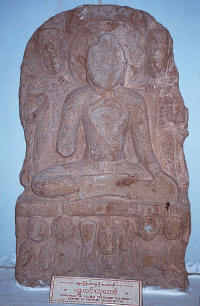
Gautama Buddha preaching the First Sermon |
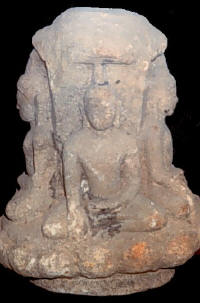
Four earth touching Buddhas, terra cotta |
There are several remarkable depictions of the four Buddhas of the past on
silver repousse reliquaries. There are also representations of a fifth
Buddha, Maitreya, the Buddha of the Future.
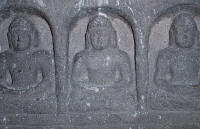
Three of the identical five Buddhas of the past, stone slab from Khin Ba’s mound
|
Several bronze images believed to depict Maitreya have come to light,
although they may be the bodhisattva Avalokiteshvara without his usual
identifying marks. However, one of these curious images has the name
Maitreya (incorrectly?) written on its base. The interest in Maitreya, the
Buddha as well as the Bodhisattva of the Future (like Gautama Buddha, he
is both a Theravada and Mahayanna deity), arises from a belief that he
will return to save the world. This concern with Maiteya as a savior
figure continues during the Pagan Period where it is an inspiration for
creating votive plaques and for the creation of one of the world’s rare
building types: pentagonal temples that have a shrine for each of the four
Buddhas of the Past as well as one for Maitreya.
Most sculptures at Srikshetra are typically in high relief with a heavy
stele backing, although some large single sculptures in the round have
been discovered. One such sculpture from the Kan-wet-khaung-gon mound is
made of stone and depicts the Buddha in a seated meditation posture with
two hands placed on his lap. This is a particularly important image, not
only because it is free standing but because it can be dated to the late 7th
century by the bilingual inscription on its base. The inscription is
fortunately not only in Pyu but Sanskrit as well, the script of which can
be dated. This image is then one of the few dated benchmarks that can be
used to establish a developmental chronology for Pyu sculpture.
Of particular interest is a cylindrical gilded silver casket found in the
relic chamber of the Khin Ba mound. In a style derived from the North
Indian Gupta style, it is embossed with the last four Buddhas of the
present world cycle seated in the earth-touching posture with a standing disciple
between each of them. The casket has a flat lid. A banyan tree rises from
its center that was once adorned with metal twigs
and leaves. Inscribed around the rim of the lid is a Pyu-Pali inscription
in South Indian characters. The inscription identifies each Buddha by
name as well as their disciples; it also records two names, probably of donors.
A smaller reliquary casket shaped like a cube is without a lid or base and
has a meditating Buddha seated on each face. Both reliquaries are
executed in a precise and beautiful repousse technique.
It is not possible to give a detailed description of the Pyu style of
image because so many different styles co-existed. Indeed, images that
turn up and don’t fit any of the known Burmese styles, are frequently, and
often inaccurately, dubbed “Pyu”.
ii.
Mahayanist
Sculpture
A
number of Mahayanist images appear in the assemblage of sculpture from
Srikshetra: a beautiful Avalokiteshvara, the Maitreyas mentioned
previously, and several bodhisattvas as well as female deities that at
present have not been more precisely identified.
iii. Hindu Sculpture
The Hindu images that have come to light are almost all associated with
the god Vishnu, the second member of the supreme Hindu triad, the king of
the gods, and the model for kings on earth. He is easily identified by his
major attributes the club-scepter and discus. Examples of him standing on
the shoulders of his winged mount, Garuda, with a female goddess have been
uncovered. Several representations of Vishnu reclining on Ananta, his
loyal serpent-protector have been found not only at Srikshetra but in the
Mon countries as well. A truly extraordinary image, long identified as a
guardian figure or devarapala has recently been identified as a standing
Garuda, - perhaps with Tantric associations.
Several secular figures have also come to light. An exceptionally fine
collection of bronze figures was discovered in an excavation near the
Pyama stupa. Five bronze Buddhas along with five animated figures that
together constitute a wandering troupe of entertainers: a flute player, a
drummer, a cymbalist, and a dancer, along with what seem to be a dwarf
clown carrying a sack. All of the figures in the troupe are beautifully
cast although they are all less than four and one half inches tall.
A
truly enigmatic two-faced stele was discovered that is thought to depict a
warrior king accompanied by his two lieutenants. On the reverse, two women
- the king’s wives? - hold an empty throne awaiting the king’s arrival.
If the recent identification is correct, it is a representation unique
within the history of Burmese art.
Also of interest is an ornately molded bronze bell that measures eleven
inches in height and is decorated with two emblems of srivatsa, a symbol
that frequently appears on Pyu coins.
f. Srikshetra: other arts
Small objects and statuettes made of gold, silver, and copper have also
been found at Srikshetra. Such objects include miniature stupas of silver,
gold and silver caskets, models of boats, ducks, deer, butterflies, lotus
flowers, gold and silver rings, necklace of elephants made of jade, and a
variety of beads made of carnelian, amethyst, crystal, quartz, agate, and
glass.
i.
Animist Arts
Earthenware funerary urns of varying shapes and sizes were found while
excavating mounds scattered throughout the city and its environs. Most of
the urns contain calcified bones mixed with ashes and loose earth. The few
copper and stone urns that have been found were probably used for the
burials of royalty. This was almost certainly the case because the four
large stone urns that were discovered near the Payagyi pagoda each bear a
brief epitaph recording the names of royalty and their dates.
|
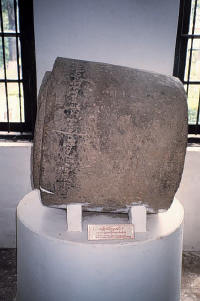
Inscribed Stone Urn, side view |
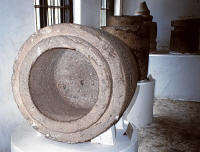
Inscribed Stone Urn, top or inside view |
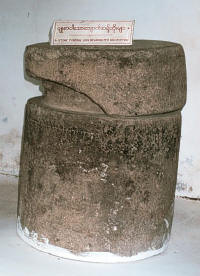
Inscribed Stone Urn with lid |
|
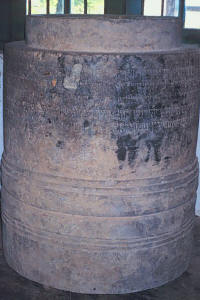
Inscribed Stone Urn without lid |
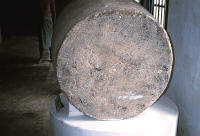
Inscription on base of Urn |
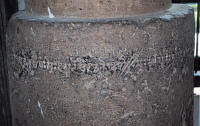
Inscription on side of Urn |
The use of urns, both stone and ceramic, for secondary burial is a
widespread trait in early Southeast Asia. Their use during the Pyu Period
is probably the continuation of an earlier megalithic practice.
E. Pyu City States: Conclusion
What little is known concerning the decline of the Pyus comes only from
Chinese sources which claim that invasions in the ninth century from
Yunnan province in China occupied areas that had once belonged to the Pyus.
One Chinese chronicle refers to the defeat of the Pyus and the capture of
three thousand residents from what was probably Halin. However, there are
no firm indications at Srikshetra or at any other Pyu site that suggests a
violent overthrow. These incursions are thought to have weakened the
Pyu
State so that by the ninth century the Burmese were able to move down into
what had been Pyu territory and settle in Kyaukse and the Pagan region.
The Pyus left their mark on the Pagan State; in as much as the site of
Srikshetra was incorporated into the state ideology. The first kings at
Pagan traced their mythical genealogy back to the kings of Srikshetra, a
continuity in political life that is not found elsewhere in
Southeast Asia. On
balance, however, a considerable gap exists between the fall of the Pyus
in the ninth and the earliest datable Pagan shines to the 11th
for the Pyus to have played an important part in creating the artistic and
cultural life of Pagan.
The Pre-Pagan Period: The Mon and Pyu
City States -Bibliography
Aung Thaw, Excavations at Beikthano (Rangoon, Ministry of Union
Culture, 1968).
Aung Thaw, Historical Sites in
Burma
(Rangoon, Ministry of Union Culture, 1972).
Michael Aung Thwin, “Burma Before Pagan: The Status of Archeology Today”,
Asian Perspectives, XXV, (1982-83), pp. 121. [Published 1988]
John Guy, “The Art of the Pyu and the Mon” in Donald Stadner, ed., The
Art of
Burma, New Studies
(Mumbai, Marg Publications, 1999), pp. 13-28.
G. H. Luce, Phases of Pre Pagan Burma (Oxford, 1985), vol.1 & 2.
Donald Stadner, “The Art of Burma” in Maud Girard-Geslan…[et al.], The
Art of Southeast Asia (New York,
Harry N. Abrams, 1997), pp.39-92.
Janice Stargardt, The Ancient Pyu of
Burma,
Vol. I (Cambridge and Singapore, PACSEA and ISEAS, 1990).
Paul Wheatley, Nagara and Commandery: Origins of the Southeast Asian
Urban Traditions (Chicago, 1983).
Robert S. Wicks, “The Ancient Coinage of Mainland Southeast Asia,
Journal of Southeast Asian Studies, XVI, no. 2 (September 1985), pp.
195-217.
Robert S. Wicks, Money, Markets, and Trade in Early
Southeast Asia: The
Development of Indigenous Monetary Systems to AD 1400
(Ithaca, Cornell University Southeast Asia Program, 1992). |